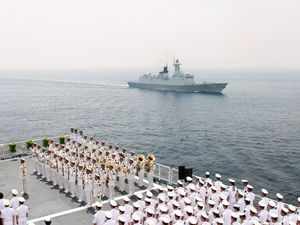 Getty Images
Getty ImagesChina is also using the People’s Armed Forces Maritime Militia, China’s armed fishing fleet, as a gray zone actor to assert its claims to disputed territories in SCS region.
China claims everything within the “nine-dash line,” stretching from Taiwan to Malaysia – a vaguely defined boundary purportedly based on old maps. In 2016, the international tribunal at The Hague ruled there was no legal basis for such a claim. China rejected the decision, and other countries have continued to complain about Chinese vessels in their waters. But the 2016 verdict is legally binding and China should honour it and must be pressured to honour it.
In a subtle but clear message for China, India during a recent East Asia Summit (EAS) meet has asserted that the Code of Conduct for SCS, being negotiated between China and ASEAN, should not prejudice the legitimate interests of third parties and should be fully consistent with the United Nations Convention on the Law of the Sea (UNCLOS). India should maintain this position and back Vietnam’s (its key strategic partner in the region) on the SCS issue. India has strategic and economic interests in the SCS region. Over 50 per cent of India's global trade passes through SCS. Global powers should also back Hanoi.
Beijing often invokes the so-called nine-dash line to justify its apparent historic rights over most of the resource-rich SouthChina Sea region where Vietnam, Philippines, Malaysia, Brunei and Taiwan also have claims. But China often intimidates other claimants through display of force by its Navy and Coast Guard and created artificial islands in the SCS region where it has installed military equipment.
In 2018, Vivekananda International Foundation (VIF) in a report noted, “Chinese ambitions for hegemony is evident from many unilateral actions in the SCS. But in the recent past China has faced active criticism from all quarters, which has affected its international prestige. It has also attracted a countervailing great- power alliance/ partnership between Australia, India, Japan and US under the rubric of Quad which is yet to fructify in a substantive way. The judgement of PCA has further de-legitimised China’s hostile actions in the SCS. In this backdrop, China should be continually pressured to adhere to international norms as also to move forward on concluding COC. International pressure has to be sustained on China till it plays by the rules.”
Leading Australian think-tank Lowy Institute in a recent report explained, “The conventional wisdom is that China claims sovereignty over “virtually all South China Sea islands and their adjacent waters.” Its claims are “sweeping” and more expansive than those of any other rival claimant. In 2009, Dai Bingguo, then a top Chinese official, first referred to the South China Sea as a “core interest”, a term often used for Taiwan, Xinjiang and Tibet. While China has not been specific about the extent of its claims, it uses a “nine-dash line” which “swoops down past Vietnam and the Philippines, and towards Indonesia, encompassing virtually all of the South China Sea”, to delineate its claims.”
On the surface, it appears that Chinese leaders are relying on a historical argument to buttress their claims – China traces its interaction with the South China Sea back to the Western Han Dynasty. Thus, Beijing’s narrative about its claims begins as early as the 2nd century BCE, when Chinese people sailed in the South China Sea and discovered some of the region’s land features, according to the Lowy Institute report.
“The United Nations Convention on the Law of the Sea formalizes countries’ rights and responsibilities on the world’s oceans. The convention established the idea of exclusive economic zones: the area stretching 200 nautical miles from a state’s coastline, where it has special rights to exploit resources. Where countries’ EEZs overlap, UNCLOS says they must negotiate,” according to a recent report in the Christian Science Monitor.
The SCS reportedly has 11 billion barrels of oil, around 190 trillion feet of natural gas, 40 percent of global liquified natural gas (LNG), and 12 percent of the world’s fisheries and one third of world’s shipping trade flows through SCS.
China’s strategy is to have assets in both the Pacific Ocean and the Indian Ocean, and the SCS is a link between the two.
UNCLOS was signed by over 150 countries, including China. Even though China is a signatory to UNCLOS, it skips the issue of being a signatory by using the nine-dash line.
Download The Economic Times News App to get Daily Market Updates & Live Business News.
Subscribe to The Economic Times Prime and read the ET ePaper online.
Read More News on
Download The Economic Times News App to get Daily Market Updates & Live Business News.
Subscribe to The Economic Times Prime and read the ET ePaper online.












 Get Unlimited Access to The Economic Times
Get Unlimited Access to The Economic Times
